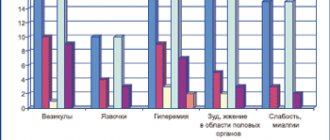The active substance of the drug is loperamide hydrochloride, an antidiarrheal agent. The drug is available in several forms for oral administration:
- tablets: odorless, white, round, scored, dosage 2 mg, packaged in blisters of 10 pieces;
- capsules: elongated, with an opaque shell of gray and yellow colors, inside they contain white powder with active and auxiliary components.
Form-forming and stabilizing additives of the drug: silicon dioxide, starch, lactose, talc, magnesium salts, gelatin, dyes. Lopedium cardboard packaging contains 1–5 blisters of 10 tablets or capsules.
Pharmacodynamics and pharmacokinetics
Loperamide is a synthetic derivative of piperidine . It acts on peripheral opioid receptors , reducing the production of acetylcholine and prostaglandins . Thus, the propulsive peristalsis of the small intestine decreases, bowel movements occur with less frequency, and the feces acquire a harder consistency.
Indications for use of the drug are frequent bouts of diarrhea. This is due to the ability of the drug to increase the tone of the anal sphincter and reduce the frequency of bowel movements.
After taking the tablets, they quickly enter the bloodstream after being absorbed into the gastrointestinal tract . 4-5 hours after administration, loperamide reaches its maximum concentration in the blood plasma and, in a fairly small amount, can penetrate the blood-brain barrier .
It undergoes metabolic reactions in the liver, is excreted after 9-14 hours in the feces, and a small amount is excreted through the kidneys.
Due to the fact that the drug is metabolized in the liver, consultation with a doctor and dose adjustment for patients with liver disease is required.
How does Lopedium work?
Loperamide dissolves in the intestinal lumen, increases the viscosity of feces, reduces water absorption, and reduces the tone of muscle walls. The mechanism of action is based on the effect of the drug on specific receptors that regulate peristalsis. As a result of taking the drug, the time it takes for food masses to pass through the gastrointestinal tract increases, and attacks of diarrhea stop or become less frequent.
After taking a dose of the medication, its effect increases and lasts about 6 hours. The effect occurs after the first capsules (tablets): the urge to defecate decreases. Lopedium components are transformed under the influence of bile acids. Most of the metabolites are excreted in feces, and a small part is excreted in urine. The drug acts predominantly in the intestinal space, a small amount of it penetrates into the systemic bloodstream. The remedy for diarrhea does not lead to intoxication of the body and does not accumulate in tissues. Complete elimination of its residues occurs within 19–24 hours after administration.
Indications for use
The drug can be prescribed for any type of diarrhea .
Lopedium - what are these pills for?
- treatment of chronic, allergic, emotional, medicinal and radiation diarrhea;
- an additional remedy for the treatment of infectious diseases of the gastrointestinal tract (together with antibiotics );
- diarrhea caused by a change in diet, metabolic disorders, and certain gastrointestinal tract ;
- elimination of diarrhea during ileostomy .
Lopedium tablets - for what else?
An indication for the use of the drug may also be digestive disorders in tourists ( traveler's diarrhea ). Capsules can be taken for 2 days. If blood appears in the stool, you should consult a doctor.
Use of the drug Lopedium
For acute and chronic diarrhea, the initial dose is 2 capsules for adults and 1 capsule for children aged 5 years and older; in the future, 1 capsule is prescribed after each subsequent liquid bowel movement. For chronic diarrhea, the maintenance dose is 1 capsule 1-2 times a day. The maintenance dose is selected so that the frequency of bowel movements is 1–2 times a day. The maximum daily dose for acute and chronic diarrhea is no more than 8 capsules for adults and 3 capsules per 20 kg of body weight for children. Capsules should be swallowed without chewing, with a small amount of liquid. After normalization of stool or in the absence of bowel movements for 12 hours, the drug is discontinued. If in acute diarrhea 48 hours after the start of treatment there is no clinical improvement, treatment with the drug should be discontinued and treatment tactics should be reconsidered.
Contraindications
- severe allergic reactions to the components of the drug;
- acute dysentery (blood in stool, fever);
- age up to six years;
- bacterial enterocolitis ( salmonellosis, shigellosis );
- acute colitis caused by taking antibiotics ;
- In the process of using the product, bloating , constipation , and intestinal obstruction .
Side effects
Possible:
- headache, tremor, drowsiness and loss of consciousness ;
- urinary retention, miosis;
- constipation, nausea, indigestion, megacolon;
- Stevens-Johnson syndrome , angioedema , itchy skin and urticaria .
Lopedium, instructions for use (Method and dosage)
Capsules are taken whole, do not bite, and washed down with water.
According to the instructions for use of Lopedium, it can be prescribed to adults and children starting from the age of six.
For adults, with chronic or acute diarrhea, the initial dosage is 4 mg, after each trip to the toilet (defecation). Then the dosage can be reduced to 2 mg. The maximum drug taken per day is 16 mg.
For children, 2 mg is initially prescribed, with a maximum of 6 mg per day.
The course of treatment ends upon reaching a state where the time between two bowel movements is at least 12 hours.
Lopedium, tablets 2 mg, 10 pcs.
Manufacturer
Sandoz, Switzerland
Compound
1 tablet contains Active substance: loperamide hydrochloride – 2 mg Excipients: lactose monohydrate, calcium hydrogen phosphate dihydrate, corn starch, sodium starch glycolate, colloidal silicon dioxide, magnesium stearate.
pharmachologic effect
Lopedium - obstipating, antidiarrheal.
By binding to opioid receptors of the intestinal wall, it reduces the tone and motility of intestinal smooth muscles. Slows down peristalsis and increases the transit time of intestinal contents. Increases the tone of the anal sphincter. Helps retain feces and reduce the urge to defecate. The action comes quickly and lasts 4-6 hours.
Pharmacokinetics
Absorption – 40%. The time to reach maximum concentration is 2.5 hours. Communication with plasma proteins – 97%. The half-life is 9-14 hours. It does not penetrate the blood-brain barrier. Almost completely metabolized in the liver by conjugation. It is excreted mainly with bile and kidneys.
Indications
- Symptomatic treatment of acute and chronic diarrhea of various origins (allergic, emotional, medicinal, radiation;
- when changing the diet and quality of food, when metabolism and absorption are impaired;
- as an adjuvant for diarrhea of infectious origin).
Regulation of bowel movements in patients with ileostomy.
Contraindications
- Hypersensitivity to the drug, diverticulosis, intestinal obstruction, ulcerative colitis in the acute stage, diarrhea against the background of acute pseudomembranous enterocolitis;
- as monotherapy – dysentery and other gastrointestinal infections;
- pregnancy (first trimester), lactation period;
- children under 6 years old.
With caution: liver failure.
Side effects
Headache; gastralgia, dry mouth, allergic reactions (skin rash), drowsiness or insomnia, dizziness, intestinal colic, nausea, vomiting, constipation. Extremely rare - intestinal obstruction.
Interaction
No clinically significant interactions of loperamide with other drugs have been established.
How to take, course of administration and dosage
Inside. Swallow tablets and capsules without chewing with 100 ml of water.
For adults with acute and chronic diarrhea, 4 mg is initially prescribed, then 2 mg after each bowel movement in case of loose stools. The maximum daily dose is 16 mg.
Children over 6 years of age are prescribed 2 mg after each bowel movement in case of loose stools. The maximum daily dose is 6 mg.
After normalization of stool or in the absence of stool for more than 12 hours, treatment should be discontinued.
Overdose
Symptoms: depression of the central nervous system (stupor, loss of coordination, drowsiness, miosis, muscle hypertonicity, respiratory depression), intestinal obstruction.
Treatment: antidote - naloxone; Given that the duration of action of loperamide is longer than that of naloxone, repeated administration of the latter is possible.
Symptomatic treatment: activated carbon, gastric lavage, artificial ventilation. Medical supervision is required for at least 48 hours.
Special instructions
If there is no effect after 2 days of using the drug Lopedium, it is necessary to clarify the diagnosis and exclude the infectious genesis of diarrhea.
If constipation or bloating develops during treatment, the drug should be discontinued.
In patients with impaired liver function, careful monitoring for signs of toxic damage to the central nervous system is necessary.
During the treatment period, it is necessary to replenish the loss of fluid and electrolytes.
Each tablet or capsule of the drug Lopedium corresponds to 0.01 XE.
Impact on the ability to drive vehicles and operate machinery
If drowsiness or dizziness occurs, you should refrain from driving vehicles or operating machinery.
Release form
Pills
Storage conditions
At a temperature not exceeding 25 °C.
Best before date
5 years
Active substance
Loperamide
Dosage form
pills
Purpose
Children over 4 years old, For adults, Pregnant women in the 2nd and 3rd trimester as prescribed by a doctor
Indications
Diarrhea
Information in the State Register of Medicines
Go
Barcode and weight
Barcode: 4030855000920 Weight: 0.010 kg
Overdose
Symptoms of overdose are severe depression of the central nervous system , including urinary retention, intestinal obstruction , severe depression of the central nervous system , stupor , miosis , convulsions . It should be remembered that children are more sensitive to the drug than adults.
Naloxone is a specific antidote for the drug. Repeated administration of the antidote may be necessary. of enterosorbents should not be excluded .
Special instructions for the use of the drug Lopedium
The use of the drug does not exclude the prescription of antibacterial therapy and rehydration according to indications. The metabolism of loperamide is slowed in patients with liver disease. In children aged 5–6 years, the administration of the drug requires constant medical supervision. The drug should not be prescribed for a period of more than 4 weeks without the possibility of repeated medical examination. Despite the lack of data on the teratogenic and embryotoxic properties of the drug, loperamide can be prescribed during pregnancy, especially in the first trimester, only if the expected therapeutic effect outweighs the potential risk to the fetus. Lopedium does not affect the ability to work with equipment, however, if increased fatigue, drowsiness or dizziness occurs, it is not recommended to engage in such activities.
Lopedium price, where to buy
The price of Lopedium is about 40 rubles for 10 tablets.
- Online pharmacies in RussiaRussia
- Online pharmacies in UkraineUkraine
ZdravCity
- Lopedium capsules 2 mg 10 pcs. Salutas Pharma GmbH
27 rub. order - Lopedium tablets 2 mg 10 pcs. Salutas Pharma GmbH
57 RUR order
Pharmacy Dialogue
- Lopedium (2 mg tablet No. 10) Salutas Pharma GmbH
58 RUR order
- Lopedium (caps. 2 mg No. 10) Salutas Pharma GmbH
30 rub. order
show more
Pharmacy24
- Lopedium 2 mg No. 10 capsules Salutas Pharma GmbH, Nimechchina / Lek S.A. Poland
45 UAH. order

